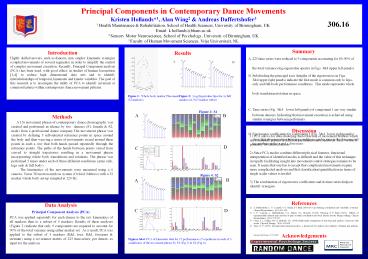Principal Components in Contemporary Dance Movements - PowerPoint PPT Presentation
1 / 1
Title:
Principal Components in Contemporary Dance Movements
Description:
1 Health Maintenance & Rehabilitation, School of Health Sciences, University of Birmingham, UK ... It seems that one has to accept that complicated movements ... – PowerPoint PPT presentation
Number of Views:46
Avg rating:3.0/5.0
Title: Principal Components in Contemporary Dance Movements
1
Principal Components in Contemporary Dance
Movements Kristen Hollands1, Alan Wing2
Andreas Daffertshofer3 1 Health Maintenance
Rehabilitation, School of Health Sciences,
University of Birmingham, UK Email
k.hollands_at_bham.ac.uk 2 Sensory Motor
Neuroscience, School of Psychology, University of
Birmingham, UK 3 Faculty of Human Movement
Sciences, Vrije Universiteit, NL
306.16
Introduction Highly skilled movers, such as
dancers, may employ kinematic synergies (coupled
movements of several segments) in order to
simplify the control of complex movement
execution. Recently, Principal Component analysis
(PCA) has been used, with good effect, in studies
of human locomotion 1-4 to reduce high
dimensional data sets and to identify
interrelationships of temporal, kinematic and
kinetic variables. The goal of this research is
to investigate the utility of PCA to identify
invariant or common features within contemporary
dance movement patterns.
- Summary
- 225 time series were reduced to 9 components
accounting for 85-90 of the total variance
(log-eigenvalue spectra in Figs. 34 upper left
panels). - Subdividing the principal axes (lengths of the
eigenvectors in Figs. 34 upper right panels)
indicate the first mode is common only to
legs-only and full-body performance conditions.
This mode represents whole body
translations/rotation in space. - Time series (Fig. 34 lower left panels) of
component 1 are very similar between dancers.
Indicating that movement execution is achieved
using similar synergies between performers. - Eigenvector coefficients for component 1 (Fig.
34 lower right panels) show that discrimination
between conditions can be seen in the forearm and
toe markers in the x and z directions.
Results
A
B
Methods A 15s movement phrase of
contemporary dance choreography was created and
performed in silence by two dancers (S1, female
S2, male) from a professional dance company.The
movement phrase was created by defining 3
self-selected reference points in space around
the body and then weaving a series of movements
in and around these points in such a way that
both hands passed repeatedly through the
reference points. The paths of the hands between
points varied from curved to straight
trajectories resulting in a movement phrase
incorporating whole body translations and
rotations. The phrase was performed 5 times under
each of three different conditions (arms only,
legs only full body). The kinematics of
the movements were measured using a 6 camera,
Vicon 3D motion analysis system (Oxford, Metrics)
with a 32 marker whole body set-up sampled at 120
Hz.
Discussion 1) PCA allows for data clustering and
extraction of movement features which are
commonly present in different performers and
conditions. Here we use it primarily for data
reduction. 2) Since PCA modes combine different
physical features, functional interpretation of
identified modes is difficult and the value of
this technique in rapidly facilitating insight
into movement control strategies remains to be
seen. It seems that one has to accept that
complicated movements require more complicated
analyses and that classification/quantification
in terms of single scalar values is invalid. 3)
The combination of eigenvector coefficients and
its time series helps to identify synergies.
- References
- A.Daffertshofer, C.J.C. Lamoth, O.G. Meijer, P.J.
Beek (2004) PCA in studying coordination and
variability a tutorial. Clinical Biomechanics
19(4)415-428. - C.J.C. Lamoth, A. Daffertshofer, O.G. Meijer,
G.L. Moseley, P.i.J.M. Wuisman P. Beek (2004).
Effects of experimentally induced pain and fear
of pain on trunk coordination and back muscle
activity during walking. Clinical Biomechanics
19(6)551-563. - Olney, S.J., Griffin, M.P. McBride, I.D. (1998)
Multivariate examination of data from gait
analysis of persons with stroke. Physical
Therapy 78(8) 814-828. - Troje, N. F. (2002). Decomposing biological
motion A framework for analysis and synthesis of
human gait patterns. Journal of Vision, 2371-387
Data Analysis Principal Component Analysis (PCA)
PCA was applied separately for each dancer to
the raw kinematics of all markers then to a
subset of 5 markers. Results of these analyses
(Figure 2) indicate that only 9 components are
required to account for 90 of the total variance
using either marker set. As a result, PCA was
applied to the subset of 5 markers (RL toes, RL
forearms sternum) using a covariance matrix of
225 time-series, per dancer, as input for the
analysis.
Acknowledgements































